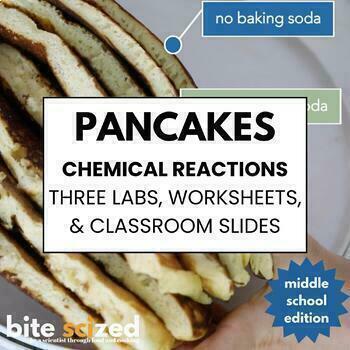Baking Soda & Pancakes Lab & Lesson Plan: 6-8 [acids/bases, chemical reactions]
Grade Levels
6th - 8th, Homeschool
Subjects
Resource Type
Standards
NGSSMS-PS1-2
NGSSMS-ETS1-1
NGSSMS-PS1-1
Formats Included
- Google Drive™ folder
Pages
40 pages

Made for Google Drive™
This resource can be used by students on Google Drive or Google Classroom. To access this resource, you’ll need to allow TPT to add it to your Google Drive. See our FAQ and Privacy Policy for more information.
What educators are saying
Really loved the multiple labs in this lesson to help students understand what baking soda is and how it works. Labs were easy and fun.
Description
In this 3-7 day lesson, students complete multiple labs and explore the chemical reaction behind baking soda in pancakes and the importance of ratios in chemical reactions.
This Lesson Includes:
- Teacher Lesson Plan with Essential Questions, Objectives, and NGSS standards, Lab Preparation (Materials, Ingredients, Amazon Lists when appropriate, and Tips & Tricks) and day-by-day lesson plans
- Classroom Slides with directions for lesson flow, turn and talk prompts, illustrations and graphics, embedded videos, and whole group reflection questions
- Student Handouts with step-by-step lab directions and other activities
- Infographic that explains key concepts
- Videos: an instructional lab video and a fun and informative Science Behind video about Baking Soda and Pancakes
Students will learn about chemical reactions and acids and bases.
All materials are included in the Google Drive folder
Total Pages
40 pages
Answer Key
Included
Teaching Duration
1 Week
Report this resource to TPT
Reported resources will be reviewed by our team. Report this resource to let us know if this resource violates TPT’s content guidelines.
Standards
to see state-specific standards (only available in the US).
NGSSMS-PS1-2
Analyze and interpret data on the properties of substances before and after the substances interact to determine if a chemical reaction has occurred. Examples of reactions could include burning sugar or steel wool, fat reacting with sodium hydroxide, and mixing zinc with hydrogen chloride. Assessment is limited to analysis of the following properties: density, melting point, boiling point, solubility, flammability, and odor.
NGSSMS-ETS1-1
Define the criteria and constraints of a design problem with sufficient precision to ensure a successful solution, taking into account relevant scientific principles and potential impacts on people and the natural environment that may limit possible solutions.
NGSSMS-PS1-1
Develop models to describe the atomic composition of simple molecules and extended structures. Emphasis is on developing models of molecules that vary in complexity. Examples of simple molecules could include ammonia and methanol. Examples of extended structures could include sodium chloride or diamonds. Examples of molecular-level models could include drawings, 3D ball and stick structures, or computer representations showing different molecules with different types of atoms. Assessment does not include valence electrons and bonding energy, discussing the ionic nature of subunits of complex structures, or a complete depiction of all individual atoms in a complex molecule or extended structure.




